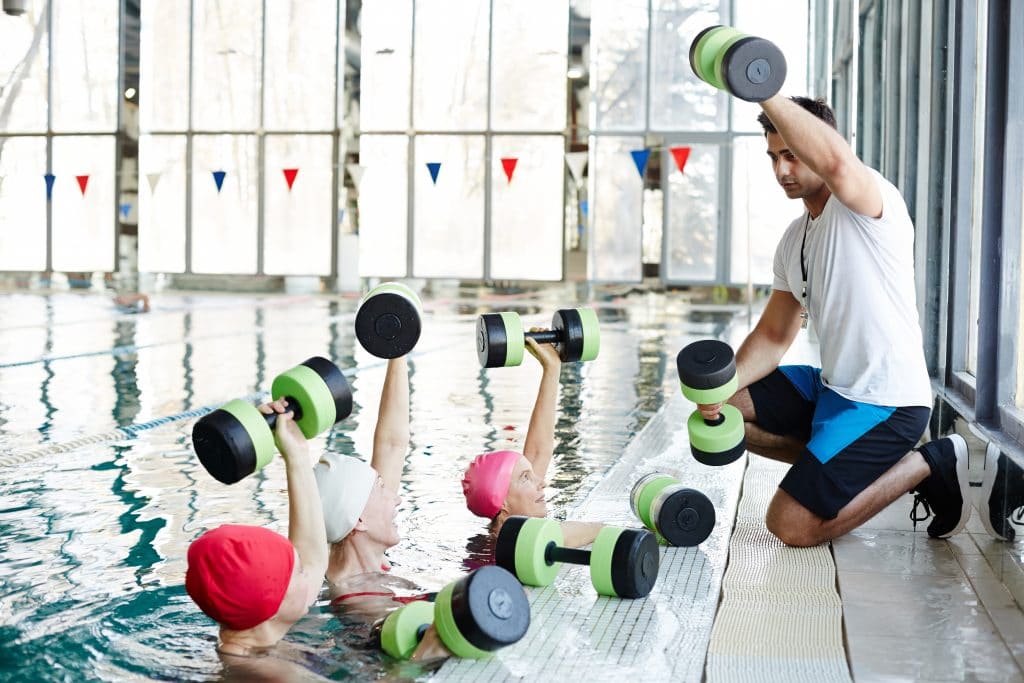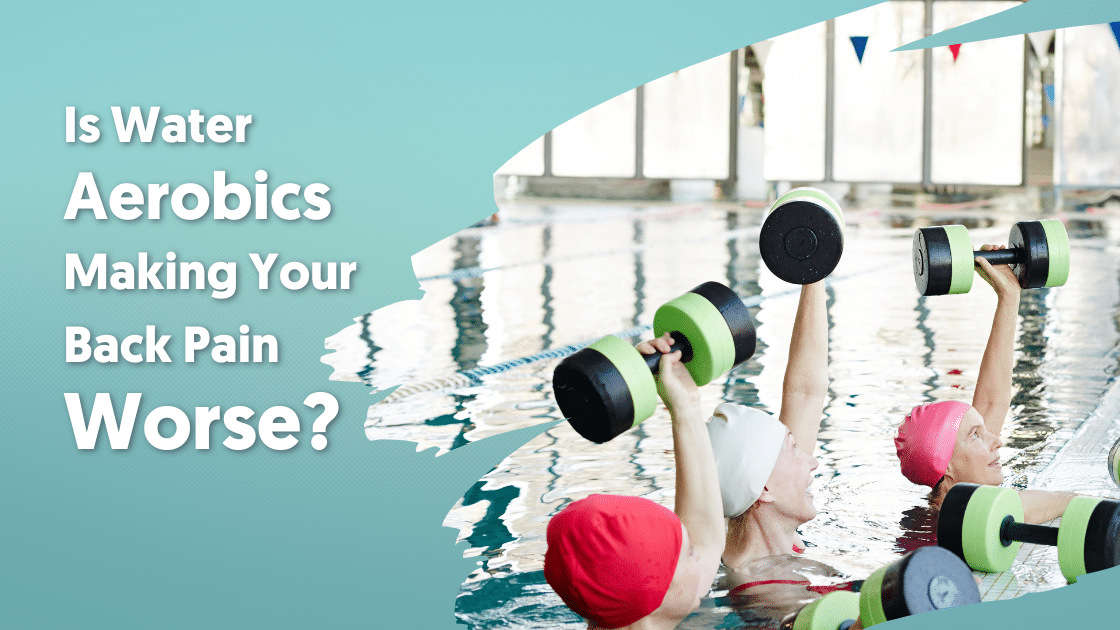Water aerobics is a popular way to exercise, especially for middle-aged and older adults. It’s a great way to stay active and healthy. But, if you suffer from back pain, there are a few things to keep in mind to prevent your pain from getting worse. Let’s take a deeper look into water aerobics…

The Surface Of Water Aerobics
Let’s start by talking about why people tend to like water aerobics in the first place. One of the upsides to an activity like water aerobics is that you can enjoy it all year long. This is especially nice if you live in an area that experiences different seasons and harsh climates. Most gyms offer classes that run every week, regardless of the time of year or weather outside. It’s a great opportunity to stay social and maintain friendships made inside the gym.
Water aerobics also presents a safe environment for anyone with a high fall risk. People with neurological and musculoskeletal conditions, like stroke and Parkinson’s disease, are able to exercise confidently and safely. For some, water aerobics is one of the few activities they can actively participate in.
People with back pain like aqua aerobics because of the lower impact on their joints and bones. They can glide freely through the water without feeling the aches and pains they typically feel when exercising on land. Some doctors may recommend water aerobics as a starting point to get moving because water provides something called buoyancy. Buoyancy supports body weight, making it easier to move and less stressful on the body.
On the surface, water aerobics seems like a great solution for back pain sufferers who want to get active. Before you start looking for your water floaties, though, let’s take a deeper look into aqua aerobics and how it impacts your health…
Diving Into The Truth About Water Aerobics
Like any exercise, water aerobics isn’t completely risk-free. It’s important to keep this in mind, especially if you have back pain, so you don’t make your pain worse.
Risky Movements
To start, not all water aerobics classes- or their instructors- are created equal. There are some movements that your body may not be ready to do in a pool. For instance, overhead movements can be really risky for your back. When you do these movements, you’re heavily relying on the muscles in your back to stabilize your spine. This added stress on your muscles, joints, and ligaments will intensify your pain and make your back even worse over time.
It’s important for the instructors to be able to recognize when they need to modify an exercise for those who shouldn’t perform them. If the class size is large enough, it can be challenging for them to make sure you’re keeping up or not doing any exercises that can cause you pain.
Short-Term Solution
Perhaps one of the biggest reasons water aerobics is actually making your back worse is because it’s a non-weight-bearing activity. Even though some doctors may recommend water aerobics to initially get moving, it should only be a short-term solution.
You spend the majority of your life out of the water. Whether you’re folding laundry or making dinner, every move you make requires you to support your own body weight. Unfortunately, the types of movement you do in a pool during water aerobics don’t carry over well onto land because the buoyancy is gone. While water aerobics may be a good starting point, you will inevitably have to transition to bearing full weight to see improvement in your recovery.
Some examples of weight-bearing exercises include:
- Walking
- Biking
- Dancing
- Tennis
- Strength Training
- Yoga
You won’t see the same health benefits if you’re only doing water aerobics. Muscles and ligaments only get stronger when they move against gravity. Weaker muscles aren’t able to support your body properly, which impacts your flexibility and range of motion.
Flexibility and range of motion are the foundation for a healthy body. They help protect you against pain and injury. Not to mention, they allow you to maintain your balance and reaction time. When you don’t perform weight-bearing activities, your joints and muscles begin to lock in place and have a much harder time working the way they should. This is especially dangerous for the health of your back because it increases your risk of falling.
Affects Bone Health
Even when you’re regularly participating in water aerobics, your bones aren’t getting the good type of stress that they need to stay healthy. Bone is living tissue that is constantly being absorbed and replaced. When it feels the force from weight-bearing exercises, your body sends signals to the bone-building cells to pick up the pace and rebuild bone even stronger. If it doesn’t go through that temporary stress, however, it starts to jeopardize the health of your spine and back.
Old bone gets removed faster than new bone gets made, causing your bones to become less dense. Over time, the lack of cell turnover can lead to conditions like osteoporosis. The risk for bone fractures significantly increases as well. So, even if you have the best intentions and think that water aerobics is the safer form of exercise, you’re actually doing yourself a disservice by not choosing a more challenging and beneficial way to get active.
The only way your bones will become stronger and more supportive is if they feel the weight and pull from your muscles during weight-bearing movement to build more bone cells. Simply doing activities like jogging or yoga can prevent the decline in bone health. Studies found that even just walking for a few hours a week can lower your risk of hip fractures by over 40%.
It’s important to gradually increase the intensity and duration of weight-bearing exercises over time. Your body needs time to adapt to stress in order to become stronger. Increasing the intensity level of your workouts may be difficult if you have arthritis or other physical limitations, but the key is to find the right balance between too much and too little exercise.
Ineffective For Weightloss
Water aerobics may seem appealing if you have a difficult time just moving your own body weight around. You know that the more weight you have, the more challenging it can be to move. But, you need to move in order to lose weight. So you pick an activity that takes body weight out of the equation, hoping that you’ll start shedding some pounds. While exercising in the water sounds like the right answer at the moment, aqua aerobics isn’t the healthy solution you’re hoping for, unfortunately.
The truth is, water aerobics has very little impact on weight loss at all. It isn’t as effective as other forms of exercising, which means you aren’t getting the same health benefits as you would with traditional weight-bearing workouts. Research shows that you burn more than 3x the number of calories per hour doing activities like walking on a treadmill or biking compared to water aerobics.
Because you aren’t burning as many calories, you’re far less likely to see changes on the scale. Consequently, this can lead to some major health issues that come with higher body weight—one of the most common issues being back pain. Excess weight puts extra stress on your bones and joints. Eventually, your lower back and pelvis give in and begin to slant forward, creating a permanent rounding arch in your back, causing you pain.
Creates Instability
Your spine feels 4 pounds of pressure for every pound you weigh. That means a person weighing 200 pounds puts 800 pounds of pressure on their spine every day. When you leave the buoyancy of the water, your body takes on that pressure, relying heavily on your vertebral discs to absorb the shock. Too much pressure can cause tears in the disc, as well as herniation or compression. When the disc space becomes compressed, the spinal nerves can get pinched, causing you excruciating pain in your lower back, hip, and even down your legs into your ankles and toes.
Your strongest muscles are in your back, but there is only so much that they can handle. Since your muscles aren’t working hard enough during water aerobics, they become weak and unable to support your spine properly. As a result, your back grows unstable and can even be pulled out of alignment. Without correction, even the smallest misalignment can have a snowball effect into bigger issues, like abnormal posture and altered gait.
Conclusion
It’s true, not all exercises are created equal. While there are plenty of health benefits to water aerobics, it may be making your back worse if you’re not careful.
It’s important to keep this in mind as you exercise, both in and out of the water. Click here to learn about lower back exercises that can strengthen your back and relieve your pain.



